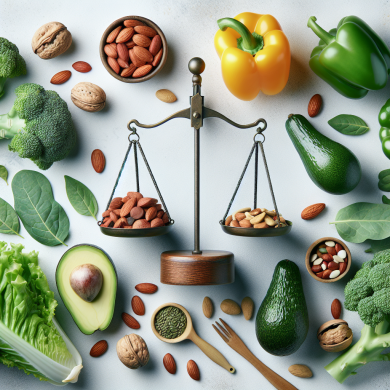Avoid These Common Keto Diet Pitfalls
“`html
Avoid These Common Keto Diet Pitfalls
The ketogenic diet, commonly known as the keto diet, has gained significant popularity over the last few years for its potential to promote weight loss and improve certain health markers. By drastically reducing carbohydrate intake and increasing fat consumption, the keto diet aims to induce a state of ketosis, where the body burns fat for fuel instead of glucose. While many have found success with this approach, there are several common pitfalls that can hinder progress and potentially lead to negative health outcomes. Understanding these pitfalls and learning how to avoid them is crucial for anyone embarking on a keto journey.
Insufficient Electrolyte Intake
One of the most common pitfalls of the keto diet is failing to maintain adequate electrolyte levels. When carbohydrates are reduced, the body releases less insulin, leading to increased excretion of sodium and water through urine. This can result in an imbalance of key electrolytes such as sodium, potassium, and magnesium.
Symptoms of Electrolyte Imbalance
An imbalance in electrolytes can cause symptoms like fatigue, headaches, muscle cramps, and even heart palpitations. These symptoms are often referred to as the “keto flu,” which can discourage newcomers from continuing the diet.
Preventing Electrolyte Imbalance
To prevent electrolyte imbalances, it’s crucial to consciously incorporate electrolyte-rich foods into your diet. Include foods like avocados, leafy greens, nuts, and seeds, which are high in potassium and magnesium. Additionally, consider using a high-quality sea salt to boost sodium intake and drinking bone broth, which is rich in minerals.
Not Eating Enough Fiber
Another common pitfall is neglecting fiber intake. Many people focus so heavily on reducing carbohydrates that they inadvertently eliminate fiber-rich foods from their diet. Fiber is essential for digestive health, helping to prevent constipation and maintain a healthy gut microbiome.
Incorporating Fiber on Keto
To combat this issue, incorporate low-carb, high-fiber foods like chia seeds, flaxseeds, and non-starchy vegetables such as broccoli and spinach. These foods not only provide fiber but also add essential nutrients to your diet.
Supplementing with Fiber
If getting enough fiber from food alone is challenging, consider taking a fiber supplement. Look for options that are low in carbohydrates and fit within your macronutrient goals.
Overconsumption of Protein
While protein is an important component of the keto diet, consuming too much can interfere with achieving and maintaining ketosis. When protein intake is too high, the body can convert excess protein into glucose through a process called gluconeogenesis, potentially taking you out of ketosis.
Balancing Protein Intake
To avoid this, aim for moderate protein intake. Calculate your protein needs based on your body weight, activity level, and specific goals, and strive to meet but not exceed this amount. Choosing high-quality protein sources like fatty fish, eggs, and grass-fed meats can help you stay within your target range.
Ignoring Hidden Carbohydrates
Carbohydrates can sneak into your diet from unexpected sources, especially when consuming processed foods. Many products labeled as “low-carb” or “keto-friendly” may contain hidden carbs due to added sugars or fillers.
Reading Labels Carefully
To avoid hidden carbohydrates, it’s essential to read labels carefully. Pay attention to serving sizes and ingredient lists, and be wary of products with long lists of additives and preservatives. Opt for whole, unprocessed foods whenever possible to minimize the risk of hidden carbs.
Not Tracking Macros
Tracking macronutrients (macros) is a critical component of the keto diet. Failing to track can lead to an imbalance in your macro intake, potentially hindering progress and throwing you out of ketosis.
Using Tracking Tools
Utilize apps and tools designed to track your macro intake. These tools can help you stay within your daily goals and make adjustments as needed. Regular tracking also allows you to identify patterns and make informed decisions about your diet.
Overemphasis on Processed “Keto” Foods
With the rise in popularity of the keto diet, the market has been flooded with processed foods labeled as “keto-friendly.” While these products offer convenience, relying too heavily on them can be a pitfall due to their potential lack of nutrients and the inclusion of artificial ingredients.
Focusing on Whole Foods
Instead of relying on processed foods, prioritize whole, nutrient-dense options. Foods like eggs, avocados, nuts, seeds, and fatty fish provide the necessary nutrients to support overall health while helping you stay in ketosis.
Neglecting to Monitor Ketone Levels
Monitoring ketone levels can provide valuable insight into your body’s state of ketosis. Neglecting this aspect can lead to uncertainties about whether you’re truly in ketosis or not.
Methods for Monitoring Ketone Levels
There are several methods to monitor ketone levels, including urine strips, blood meters, and breath analyzers. While urine strips are the most affordable, they may not be the most accurate over time. Blood meters provide more precise readings and are considered the gold standard for monitoring ketosis.
Ignoring Individual Variability
One of the most significant pitfalls is failing to recognize that the keto diet is not one-size-fits-all. Individual responses to the diet can vary based on genetics, activity level, and health status. What works for one person may not work for another.
Customizing Your Keto Diet
To maximize success, take the time to customize your approach to the keto diet. Listen to your body and make adjustments as needed. This might include altering your macronutrient ratios, incorporating intermittent fasting, or experimenting with different food choices.
Conclusion
The keto diet can be an effective tool for weight loss and improved health, but it’s essential to approach it with awareness and vigilance to avoid common pitfalls. By maintaining proper electrolyte levels, ensuring adequate fiber intake, balancing protein consumption, and being mindful of hidden carbs, you can enhance your chances of success. Additionally, prioritizing whole foods, tracking macros, monitoring ketone levels, and recognizing individual variability will further support your keto journey. With these strategies in mind, you’ll be better equipped to navigate the challenges of the keto diet and achieve your health goals.
“`















Add comment